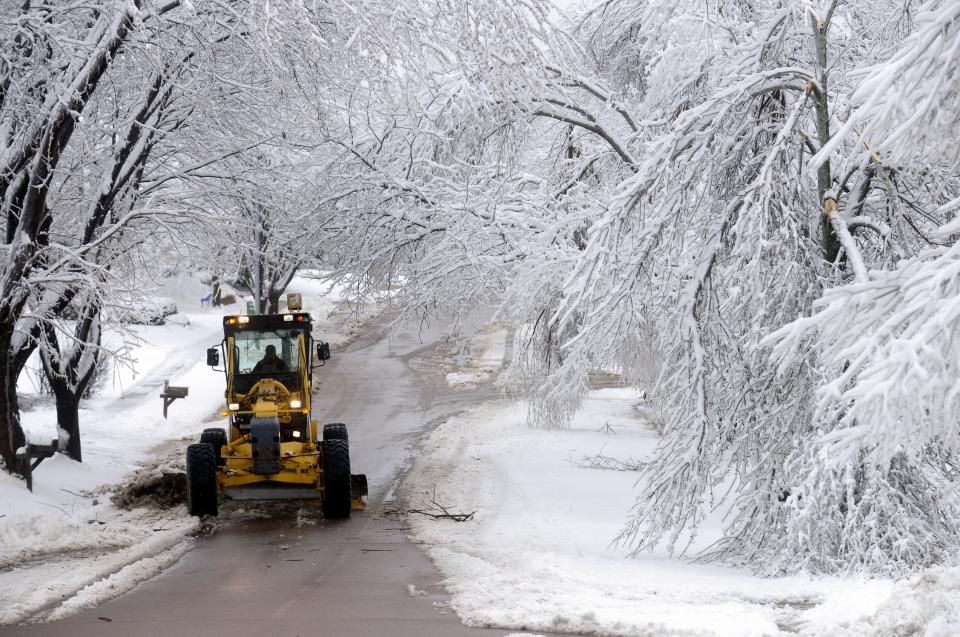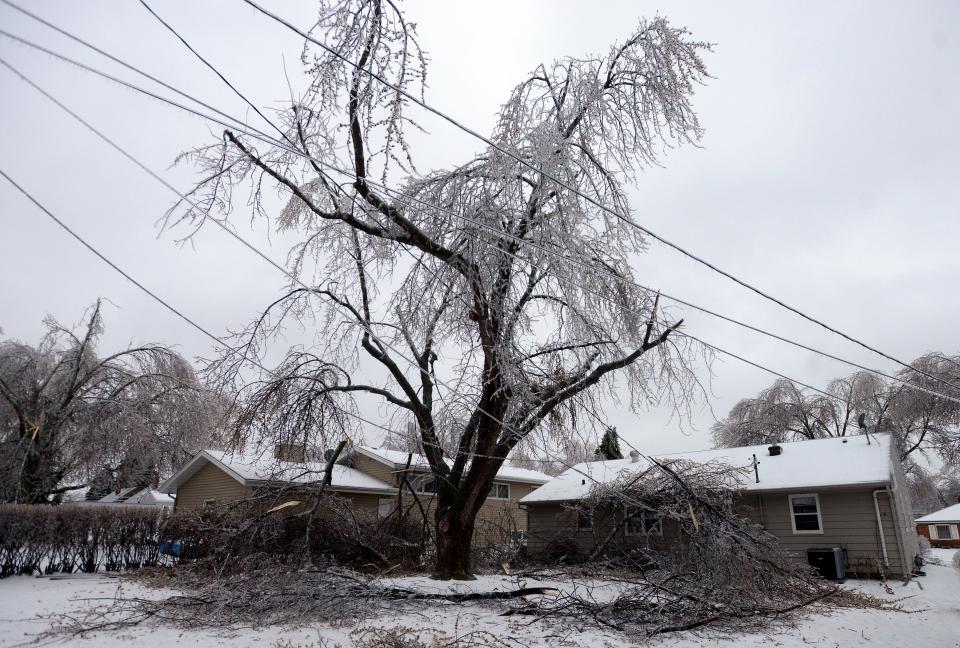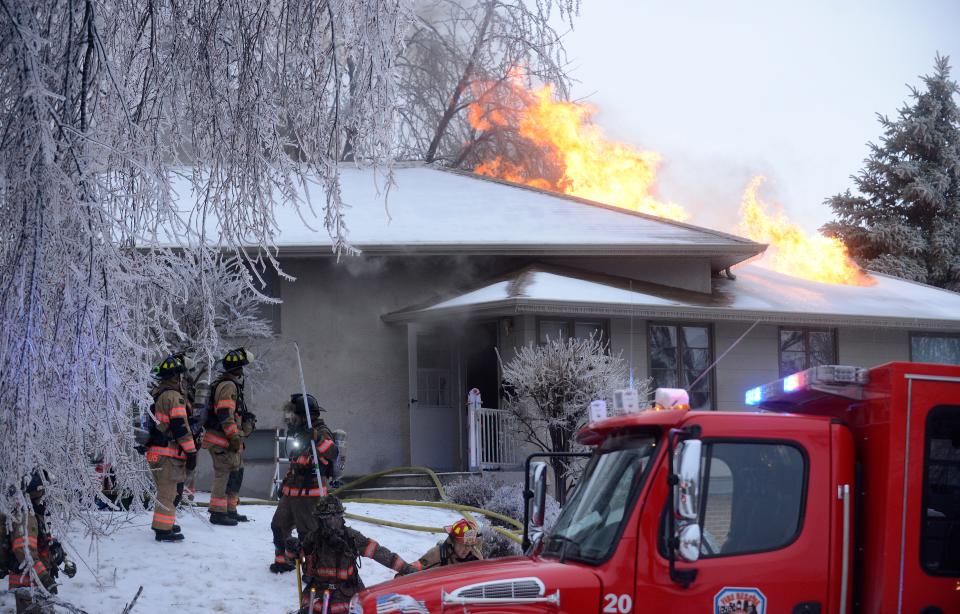Remembering 'Icepocalypse' 2013: Felled trees, lost power and birds falling out of the sky
Ten years ago, a layer of ice and snow buried Sioux Falls in a storm oft-remembered as ‘icepocalypse.’
The storm took out hundreds of trees, downed power lines and left tens of thousands of people in the dark for days.
While it tested the resilience of residents, city workers and first responders, the ‘icepocalypse’ also created opportunities for neighbors to help neighbors and demonstrate some good old-fashioned “Midwest nice.”
And, of course, it all makes for a good story. Here’s a look back at the storm:
Tuesday, April 9: 'This is going to go on for days'
The storm begins with about 0.84 inches of freezing rain. Flights in and out of Sioux Falls are canceled. I-90 is closed between Sioux Falls and Rapid City. Schools and businesses are closing. And it's just the beginning.

Mayor Mike Huether (in an April 10, 2013 Argus Leader story): This is the perfect storm. It's wet, there is ice. But there is wind coming, more ice and snow coming. This is going to go on for days.
Doug Barthel, former police chief: We were extremely busy, especially for the first day. I think at some point we had at least 70 calls holding. It's not uncommon to have calls holding, but that much is very rare.
Jim Sideras, former fire chief (In an April 10, 2013 Argus Leader story): You should plan to be ready to stay in your homes until Thursday depending on how bad this gets.
Lincoln High School students are in the dark and they are tweeting. check out hashtag #LHSBlackout
— ArgusLeader911 (@Argus911) April 9, 2013
Hunter Dunteman, resident: I was an 8th grader and Harrisburg called off — I believe — the entire week of school. I stayed a few days at a friend’s house in Sioux Falls, and at night we would walk his neighborhood, and you could just hear trees cracking overhead. We made fun out of throwing a rubber mallet at street signs and light poles and watching the inches of ice shatter.
Wednesday, April 10: 'All I could hear were trees toppling over'
Huether declares a state of emergency as the storm rages on. More than 21,500 are without power, and the forecast shows another nine inches of snow could be coming for the city. Police are responding to four times the number of calls they usually see in a day, and Metro Communications was 'swarmed' with 911 callers. Even postal workers are stalled by the snow.
Huether (In an April 11, 2013 story): Right now we are facing some challenges that we haven't had before. There is a solid chance you will lose your power. We have a long way to go before this is over. We need to stay positive, patient and safe.

Zach Heintz, resident: I remember walking outside delivering newspapers on the second day of the ice storm. I lived in a quiet neighborhood, and all I could hear were trees toppling over.
Barthel: You could hear when a tree gets to that point overloaded with the ice and the branch breaks. It’s basically like an explosion. Like a gun going off. You can hear those trees breaking off in the neighborhood. It was a dangerous time to be out and about.
Adam Weber, Embrace pastor (in an April 11, 2013 story): My wife was making breakfast, and she suddenly yelled, 'Adam! A large bird just fell out of the sky!' That was the last thing I expected to see when I looked out on my deck yesterday.
House at 13th and Prairie. Homeowners are working on cutting up the tree and hauling it away. pic.twitter.com/GuXvIS0PAY
— ArgusLeader911 (@Argus911) April 10, 2013
Katie Gebauer, resident: My little brother was born in March of 2013. Our power went out, and so between my parents and my siblings we would sit by the fire and make sure he stayed warm enough. He also didn't drink warm milk for that whole week.

Thursday, April 11: 'Turning a corner'
Sioux Falls sees between 5 and 8 inches of snow, further weighing down tree limbs and power lines. More than 24,000 are still without power. Students have been out of school most of the week. Hundreds of additional workers from neighboring states come to help put up downed power lines.
Huether: Sioux Falls, I strongly believe that we’re turning a corner; however, we still have a long, long way to go.
The heavy, wet snow also caused problems for snowplows throughout the city. Hanging branches and fallen debris allowed for only one lane to be plowed in some areas, leaving large mounds of snow on either side.
Public Works Director Mark Cotter: We're getting some feedback from the public that that's not working very good.
After three days of missed school, Sioux Falls School Board members weigh the reality that the school calendar will need to be extended. The last day had been planned for May 15. But the ice storm, combined with a closure earlier in the year, moved the date to May 21.
Doug Morrison, former Sioux Falls school board president: We really don’t have a choice.
The clean-up was underway, and tree service providers were in big demand. Eric Kersh, a member of a crew from ATS Tree Service, eyed a yellow, ankle-deep puddle alongside a tree downed at the Harrisburg Post Office.
Kersh: “This is going to suck."
Todd Heitkamp with the National Weather Service: (warning people to be wary of falling branches and ice) If you’re not conscious of (falling limbs/ice) you’re going to be unconscious.
Friday, April 12: 'How are we ever going to recover from this?'
Gov. Dennis Daugaard declares an emergency, freeing up state resources and starting the process for federal aid.
Sideras: This effort is going to go on for months. We're not going to be done with this tomorrow, or next week, although we'd like to. We're all in this together, we're going to get through this together, but we're going to need everybody's help.
After days without power, resident Nancy Johnson learned that if the electrical wire attached to the house is down, it’s the homeowner’s responsibility and not Xcel Energy’s.
Johnson: I could have easily had that possibly fixed by now, but I have lost four days because I believed what they told me.
As the city started to get a handle on the magnitude of the storm's impact, Sioux Falls Emergency Manager Regan Smith said it became clear the cleanup would take months.
Smith: There was a massive amount of debris. Our 911 center was overwhelmed with calls. Blocked roads, extended power outage throughout our community, school closures. So really, just about everybody was impacted in some way.
Cost estimate for cleanup: Hundreds and hundreds of thousands. "We're not quite to a million yet," Huether said.
— ArgusLeader911 (@Argus911) April 11, 2013
Parks Director Don Kearney: When we drove by our McKennan Park or any of the other parks that are heavily wooded, you thought, 'how are we ever going to recover from this?' It looked like a bomb went off.
Saturday, April 13: Sun and warmth return
The day brings sun, warmer weather and a sense that clean-up efforts can begin full throttle. The city announces it is hiring temp workers to aid in the effort. Meanwhile, 7,800 customers out of 82,000 who lost power are still without electricity.
Jim Wilcox, Xcel Energy spokesman: I think we can make some great progress today.
After the storm: 'I don't know if there's going to be another event like this'
Post-'icepocalypse' recovery took months.
On April 16, the city unveils a long-term plan to deal with downed branches and mangled trees throughout the city. Officials said they would begin collecting branches that residents piled between their curbs and sidewalks, dubbing it “Operation Timber Strike.” That effort ultimately removed more than 900 trees and 25,000 branches, costing $8.2 million.
Huether: We need to tackle 73 square miles of neighborhoods, homes and businesses.
On May 8, Cotter announces that 80 percent of the branches had been collected. Crews would begin on May 20 to make a final pass throughout the city for branches.
Cotter: Cleaning the city up has been a community effort and will be in our memories for many years to come.
By July 3, Cotter announces that branches and dangerous trees have been removed from neighborhoods and parks. Nearly 750 people were involved. But Operation Timber Strike isn't over. Clean-up efforts shift to clearing branches and trees from along the Big Sioux River. Stump grinding continues on city streets and parks, and all the collected wood needs to be mulched.
Six months after the storm, an effort dubbed ‘Tree the Town’ was formed by the Argus Leader, KELO-TV, the United Way, Lewis Drug, Ace Hardware, Landscape Garden Center, Cliff Avenue Greenhouse and the Helpline Center. On a cold October Saturday, volunteers from across our community planted more than 400 trees to try and replenish the city’s landscape.
Cory Myers, Argus Leader news director: There were a ton of worthy efforts around the recovery from 2013’s ice storm. I’m particularly proud of Tree the Town for really trying to move our community forward, to heal from the scars of the storm and to invest in Sioux Falls.
It all comes to an end on Dec. 4.
Huether (in a 2013 Argus Leader story): I don't know if there's going to be another event like this. This town, this government, our people — we are ready," Huether said as he announces the conclusion of Operation Timber Strike. The city removed 55,000 tons of ground debris and 972 hazardous trees at a cost of $8.2 million. The Federal Emergency Management Agency reimbursed $6.5 million.
Huether: It turned out to be probably the greatest weather-related emergency in city history. ... We all rallied around together to ultimately make good things happen. And I'm just so proud of our city.
This article originally appeared on Sioux Falls Argus Leader: What happened during Sioux Falls' 'Icepocalypse' in 2013?

